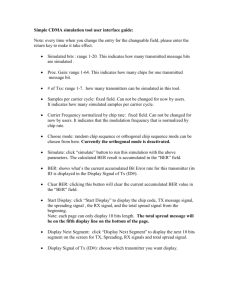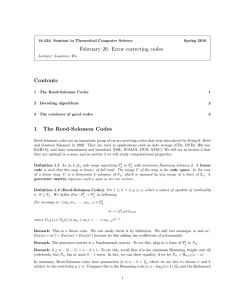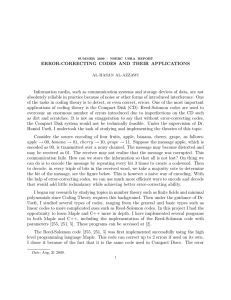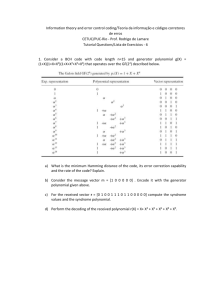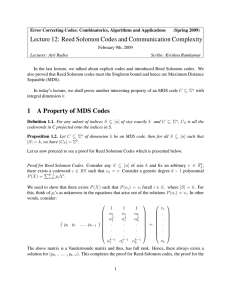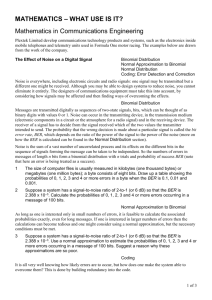A Study on performance evaluation of Reed
advertisement
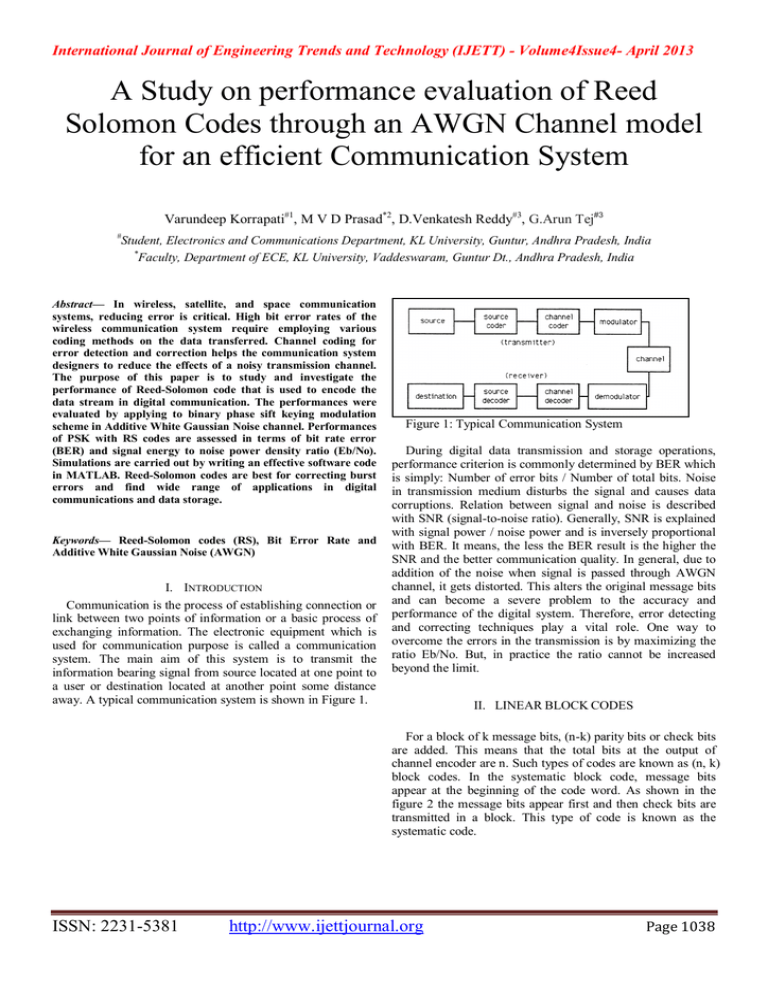
International Journal of Engineering Trends and Technology (IJETT) - Volume4Issue4- April 2013 A Study on performance evaluation of Reed Solomon Codes through an AWGN Channel model for an efficient Communication System Varundeep Korrapati#1, M V D Prasad*2, D.Venkatesh Reddy#3, G.Arun Tej#3 # Student, Electronics and Communications Department, KL University, Guntur, Andhra Pradesh, India * Faculty, Department of ECE, KL University, Vaddeswaram, Guntur Dt., Andhra Pradesh, India Abstract— In wireless, satellite, and space communication systems, reducing error is critical. High bit error rates of the wireless communication system require employing various coding methods on the data transferred. Channel coding for error detection and correction helps the communication system designers to reduce the effects of a noisy transmission channel. The purpose of this paper is to study and investigate the performance of Reed-Solomon code that is used to encode the data stream in digital communication. The performances were evaluated by applying to binary phase sift keying modulation scheme in Additive White Gaussian Noise channel. Performances of PSK with RS codes are assessed in terms of bit rate error (BER) and signal energy to noise power density ratio (Eb/No). Simulations are carried out by writing an effective software code in MATLAB. Reed-Solomon codes are best for correcting burst errors and find wide range of applications in digital communications and data storage. Keywords— Reed-Solomon codes (RS), Bit Error Rate and Additive White Gaussian Noise (AWGN) I. INTRODUCTION Communication is the process of establishing connection or link between two points of information or a basic process of exchanging information. The electronic equipment which is used for communication purpose is called a communication system. The main aim of this system is to transmit the information bearing signal from source located at one point to a user or destination located at another point some distance away. A typical communication system is shown in Figure 1. Figure 1: Typical Communication System During digital data transmission and storage operations, performance criterion is commonly determined by BER which is simply: Number of error bits / Number of total bits. Noise in transmission medium disturbs the signal and causes data corruptions. Relation between signal and noise is described with SNR (signal-to-noise ratio). Generally, SNR is explained with signal power / noise power and is inversely proportional with BER. It means, the less the BER result is the higher the SNR and the better communication quality. In general, due to addition of the noise when signal is passed through AWGN channel, it gets distorted. This alters the original message bits and can become a severe problem to the accuracy and performance of the digital system. Therefore, error detecting and correcting techniques play a vital role. One way to overcome the errors in the transmission is by maximizing the ratio Eb/No. But, in practice the ratio cannot be increased beyond the limit. II. LINEAR BLOCK CODES For a block of k message bits, (n-k) parity bits or check bits are added. This means that the total bits at the output of channel encoder are n. Such types of codes are known as (n, k) block codes. In the systematic block code, message bits appear at the beginning of the code word. As shown in the figure 2 the message bits appear first and then check bits are transmitted in a block. This type of code is known as the systematic code. ISSN: 2231-5381 http://www.ijettjournal.org Page 1038 International Journal of Engineering Trends and Technology (IJETT) - Volume4Issue4- April 2013 A block code c is constructed by breaking up the message data stream into blocks of length k and has the form (mo, m1,…..mk-1), and mapping these blocks into code words in c. The resulting code consists of a set of M code words (co, c1,........cM-1). Each code word has a fixed length denoted by n and has a form (co, c1,........cn-1). The elements of the code word are selected from an alphabet field of q elements. In the binary code case, the field consists of two elements, 0 and 1. On the other hand, when the elements of the code word are selected from a field that has q alphabet elements, the code is non binary code. As a special case when q is a power of 2 (i.e. q = 2m) where m is a positive integer, each element in the field can be represented as a set of distinct m bits [1]. Control for Systems with Feedback, Spread-Spectrum Systems, and Computer Memory. B. Parameters Reed Solomon codes are a subset of BCH codes and are linear block codes. A Reed-Solomon code is specified as RS (n, k) with s-bit symbols. This means that the encoder takes k data symbols of s bits each and adds parity symbols to make an n symbol codeword. There are n-k parity symbols of s bits each. A Reed-Solomon decoder can correct up to t symbols that contain errors in a codeword, where 2t = n-k. Block length n=q−1 Message length k Distance n−k+1 Number of parity n-k=2t check bits Minimum Distance 2t+1 Figure 2: Functional Block Diagram of a Block Coder and the Systematic Code III. INTRODUCTION TO REED-SOLOMON CODES A. History Reed-Solomon Codes are error-correcting codes with applications ranging from data retrieval from bar codes and QR codes in our daily lives to sending transmissions to and from spacecrafts launched in deep-space missions. The ReedSolomon (RS) Code was discovered by Irving Reed and Gus Solomon and was subsequently presented to the world in their paper “Polynomial Codes over Certain Finite Fields" in the Journal of the Society for Industrial and Applied Mathematics (1959). Since then, RS Codes have been an integral contributor to the telecommunications revolution that took place in the last half of the twentieth century. In particular, Reed-Solomon codes are the most frequently used digital error control codes in the world, due their usage in computer memory and non-volatile memory applications. A hurried list of significant applications includes the Digital Audio Disk, Deep Space Telecommunication Systems, Error ISSN: 2231-5381 We consider Reed-Solomon codes with code symbols from the Galois field GF (2m) (i.e., q = 2m). Let be a primitive element in GF(2m). The generator polynomial of a primitive terror correcting Reed-Solomon code of length 2m – 1 is g(X) = (X + A)(X + A2) .......... (X + A2t) = g0 + g1X + g2X2 + ....... +g2t–1 X2t–1 +X2 The code generated by g(X) is an (n, n – 2t) Cyclic code which consists of those polynomials of degree n – 1 or less with coefficients from GF(2m) that are multiples of g(X). Encoding of this code is similar to the binary case [3]. Figure 3: Block Diagram of Communication System with RS codes http://www.ijettjournal.org Page 1039 International Journal of Engineering Trends and Technology (IJETT) - Volume4Issue4- April 2013 C. Need for RS Codes No RS codes attain the major possible code minimum distance for any linear code with the unchanged encoder and output lengths. The distance between two code words is definite as the number of symbols in which the sequences differ. For RS, the code minimum distance is dmin = N – K + 1 RS codes have a significant property that they are capable of correcting any set of N-k symbols within the block. They can be designed to have any redundancy. The complexity of high speed performance increases with redundancy. RS codes have high code rates. RS codes are effective for the channels that have memory. Two information symbols can be additional to RS code length N without reducing its minimum distance [3]. D. Applications of RS Codes The Digital Audio Disc It can safely be claimed that Reed-Solomon codes are the most frequently used digital error control codes in the world. This claim rests firmly on the fact that the digital audio disc or compact disc uses Reed-Solomon codes for error correction and error concealment. Special properties of Reed-Solomon codes make the sound quality of the compact disc as impressive as it is (the signal-to-noise ratio at the output exceeds 90 dB). The compact disc system uses a pair of crossinterleaved Reed-Solomon codes. length N symbols each storing K symbols of data, being generated, that are then sent over an erasure channel. Any combination of K codewords received at the other end is enough to reconstruct all of the N codewords. The code rate is generally set to 1/2 unless the channel's erasure likelihood can be adequately modelled and is seen to be less. In conclusion, N is usually 2K, meaning that at least half of all the codewords sent must be received in order to reconstruct all of the codewords sent. Reed–Solomon codes are also used in xDSL systems and CCSDS's Space Communications Protocol Specifications as a form of forward error correction. Satellite transmission One significant application of Reed–Solomon coding was to encode the digital pictures sent back by the Voyager space probe. Voyager introduced Reed–Solomon coding concatenated with convolutional codes, a practice that has since become very widespread in deep space and satellite (e.g., direct digital broadcasting) communications. Viterbi decoders tend to produce errors in short bursts. Correcting these burst errors is a job best done by short or simplified Reed–Solomon codes. Modern versions of concatenated Reed–Solomon/Viterbidecoded convolutional coding were and are used on the Mars Pathfinder, Galileo, Mars Exploration Rover and Cassini missions, where they perform within about 1–1.5 dB of the ultimate limit imposed by the Shannon capacity. These concatenated codes are now being replaced by more powerful turbo codes where the transmitted data does not need to be decoded immediately. E. Simulation Results Bar code Almost all two-dimensional bar codes such as PDF417, MaxiCode, Data matrix, QR Code, and Aztec Code use Reed–Solomon error correction to allow correct reading even if a portion of the bar code is damaged. When the bar code scanner cannot recognize a bar code symbol, it will treat it as an erasure. Reed-Solomon coding is less common in one-dimensional bar codes, but is used by the Post Bar symbology. A full system model was implemented in Matlab. Here we have used BPSK (Binary Phase Shift Keying) modulation and demodulation for all the simulations. The encoded data is then passed through Gaussian channel which adds Additive White Gaussian Noise (AWGN) to the channel symbols produced by the encoder. In the following figures, Eb/No dB denotes the information bit energy to noise power density ratio and at the y-axis we plot the bit error rate (BER). Data transmission Specialized forms of Reed–Solomon codes, specifically Cauchy-RS and Vandermonde-RS, can be used to overcome the unreliable nature of data transmission over erasure channels. The encoding process assumes a code of RS (N, K) which results in N codewords of ISSN: 2231-5381 http://www.ijettjournal.org Page 1040 International Journal of Engineering Trends and Technology (IJETT) - Volume4Issue4- April 2013 Figure 4: BER Performance comparison of RS Codes for a fixed block length of 255 The simulations are carried out for constant block length or codeword length which is 255. From figure4, it can be seen, for the same code rate keeping block length constant the BER performance improves. Generally for RS codes the BER performance improves with the decreasing code rate and to somehow large block lengths. The RS code, which is well suited for correction of burst errors, shows a poor BER performance for lower SNR values, because of the mainly random errors introduced by the AWGN. There are a lot of applications of RS Codes. One of the applications is Satellite and Space Communications. The NASA Standard code for satellite and space communications is IV. CONCLUSIONS Through this paper we present the deep and clear understanding of Reed-Solomon codes making them simpler and easier to understand and implement. RS codes are finding increasing use in applications where reliable and highly efficient information transfer over bandwidth in the presence of data-corrupting noise is desired like recently, RS codes have been considered for many industrial standards of next generation communication systems. The purpose of this paper is to study the Reed-Solomon (RS) code. In this paper we performed the simulations of Reed-Solomon codes for the same code rates keeping block length constant. The simulation showed that the BER performance also improves for large block lengths and RS codes shows a poor BER performance for lower SNR. As the SNR value increases the curve becomes steeper. The BER Performance of NASA Standard code for Satellite and Space communication has been observed. ACKNOWLEDGMENT We thank faculty Mr. MVD Prasad for his valuable contribution in preparing this paper and helping us out many a time when we needed guidance. We are indebted to the Department of Electronics and Communication Engineering of KL University for providing the software and support required. REFERENCES [1] [2] n=255, k=223 and dmin=33 The BER performance for the NASA Standard RS (255,223) is shown below [3] [4] [5] [6] [7] Sanjeev Kumar and Ragini Gupta, Bit Error Rate Analysis of ReedSolomon Code for Efficient Communication System, International Journal of Computer Applications,Volume 30-No.12, September 2011 I.S. Reed and G. Solomon, “Polynomial Codes Over Certain Finite Fields,” SIAM Journal of Applied Mathematics, vol. 8, 1960, pp. 300– 304. A Study on Performance Evaluation of Reed-Solomon (RS) Codes through an AWGN Channel Model in a Communication System, International Journal of Computer Science and Communication, Vol. 3, No. 1, January-June 2012, pp. 37-40 Marvin K. Simon, William C Lindsey, Sami M Hinedi,“Digital Communication Techniques: Signal Design and Detection”, Prentice Hall PTR, 1994 Sanjay Sharma, “Digital Communications”, 4th Edition, S.K. Kataria & sons, 2009. R.J.McEliece, L.Swanson, “On the decoder error probability for ReedSolomon codes”, IEEE Trans.on Inf.Theory, Vol.IT-32, pp.701-703 Azlina binti Idris; Redza Fairuz bin Rahim et al.(2006) “The Effect of Additive White Gaussian Noise and Multipath Rayleigh Fading On BER Statistic in Digital Cellular Network,” Proc. of international RF and microwave conference, September 12 - 14, 2006, Malaysia. Figure 5: BER Performance of NASA Standard code RS (255,223) with dmin=33 ISSN: 2231-5381 http://www.ijettjournal.org Page 1041
